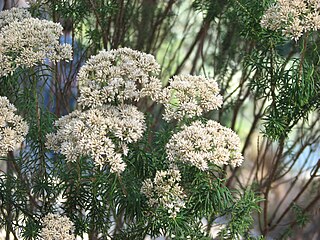
Persoonia longifolia, commonly known as snottygobble, is a species of flowering plant in the family Proteaceae and is endemic to the southwest of Western Australia. It is a shrub or small tree characterised by its weeping foliage, yellow flowers and distinctive flaky bark.

Cassinia is a genus of about fifty-two species of flowering plants in the family Asteraceae that are native to Australia and New Zealand. Plants in the genus Cassinia are shrubs, sometimes small trees with leaves arranged alternately, and heads of white, cream-coloured, yellow or pinkish flowers surrounded by several rows of bracts.

Goodenia ovata, commonly called the hop goodenia, is a species of flowering plant and is endemic to south-eastern Australia. It is a shrub with sticky, often varnished foliage, toothed egg-shaped to elliptic leaves and racemes or thyrses of yellow flowers.

Cassinia aculeata, commonly known as common cassinia, dolly bush or dogwood , is a species of flowering plant in the family Asteraceae and is endemic to south-eastern Australia. It is an erect shrub with sessile, linear, variably-sized leaves, and heads of creamy-white to white flowers arranged in rounded cymes.

Cassinia denticulata, commonly known as stiff cassinia, is a species of flowering plant in the family Asteraceae and is endemic to eastern New South Wales. It is a shrub with yellowish stems, finely-toothed, egg-shaped to elliptic leaves, and heads of pale yellow flowers arranged in a dense corymb.

Cassinia arcuata, commonly known as drooping cassinia, biddy bush, Chinese scrub, sifton bush and Chinese shrub is a species of flowering plant in the family Asteraceae and is endemic to Australia. It is a shrub, sometimes a small tree with sessile, linear leaves, and heads of up to two hundred brownish flowers arranged in pyramid-shaped panicles. In New South Wales, the species is known as Cassinia sifton. In disturbed areas, C. sifton can become weedy.

Cassinia aureonitens, commonly known as the yellow cassinia is a species of flowering plant in the family Asteraceae and is endemic to eastern New South Wales. It is a shrub with elliptic leaves and heads of yellow flowers arranged in dense corymbs.

Cassinia laevis, commonly known as cough bush, dead finish, curry bush or rosemary bush, is a species of flowering plant in the family Asteraceae and is endemic to south-eastern continental Australia. It is a shrub with a curry-like odour, crowded linear leaves, and heads of creamy-white flowers arranged in panicles.
Cassinia compacta is a species of flowering plant in the family Asteraceae and is endemic to eastern Australia. It is a shrub with densely hairy stems, linear leaves and heads of yellow flowers arranged in dense corymbs.

Cassinia leptocephala is a species of flowering plant in the family Asteraceae and is endemic to New South Wales. It is a large, woody shrub with hairy, reddish stems, stiff linear leaves, and heads of pale yellow flowers arranged in a dense corymb.
Cassinia copensis is a species of flowering plant in the family Asteraceae and is endemic to eastern Australia. It is an erect, multi-stemmed shrub with aromatic, cylindrical leaves, and heads of creamy-white flowers arranged in a flattened corymb.
Cassinia hewsoniae is a species of flowering plant in the family Asteraceae and is native to New South Wales and the Australian Capital Territory. It is an erect shrub with a sticky, densely-hairy stems, needle-shaped leaves and flower heads arranged in flat or rounded corymbs.
Cassinia lepschii is a species of flowering plant in the family Asteraceae and is endemic to eastern Australia. It is an erect or spreading shrub with densely hairy young stems, needle-shaped leaves and flower heads arranged in flat or rounded corymbs.

Petrophile rigida is a species of flowering plant in the family Proteaceae and is endemic to southwestern Western Australia. It is a shrub with rigid, branched, needle-shaped, sharply-pointed leaves, and more or less spherical heads of hairy yellow flowers.

Prostanthera discolor is a species of flowering plant in the family Lamiaceae and is endemic to a small area of New South Wales. It is an open, erect, strongly aromatic shrub with lance-shaped to oblong leaves, and deep mauve to purple flowers with darker spots inside.

Goodenia amplexans, commonly known as clasping goodenia, is a species of flowering plant in the family Goodeniaceae and endemic to South Australia. It is a small shrub with sticky foliage, egg-shaped to oblong or elliptic, stem-clasping leaves with small teeth on the edges, racemes of yellow flowers with leaf-like bracteoles at the base, and elliptic fruit.
Goodenia trichophylla is a species of flowering plant in the family Goodeniaceae and is endemic to the southwest of Western Australia. It is an erect to ascending herb with sticky or shiny, linear leaves at the base of the plant and racemes of blue flowers.

Goodenia xanthotricha, commonly known as yellow-haired goodenia, is a species of flowering plant in the family Goodeniaceae and is endemic to a restricted area in the southwest of Western Australia. It is a herb-like shrub with sticky foliage, linear to lance-shaped leaves with the narrower end towards the base, racemes of blue flowers, and cylindrical to oval fruit.
Cassinia diminuta, commonly known as dwarf cassinia, is a species of flowering plant in the family Asteraceae and is endemic to Victoria in Australia. It is a small, erect, aromatic shrub with spreading, needle-shaped leaves that are covered with cottony hair on the underside, and corymbs of up to two hundred heads of flowers arranged in corymbs.
Cassinia complanata, commonly known as smooth cassinia, is a species of flowering plant in the family Asteraceae and is endemic to south-eastern Australia. It is a shrub with sticky, densely hairy stems, narrow linear to cylindrical leaves and heads of small flowers arranged in corymbs.













